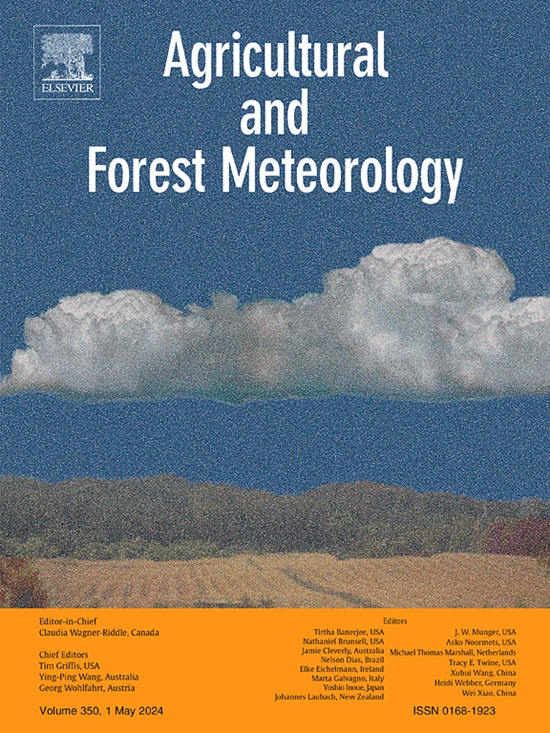Co-regulation of climate and vegetation on seasonal and interannual variations of energy exchange over a temperate grassland
IF 5.6
1区 农林科学
Q1 AGRONOMY
引用次数: 0
Abstract
Restoration of degraded grasslands can enhance productivity and promote carbon and water cycling, but changes in energy fluxes and the partitioning of net radiation (Rn) during restoration remain poorly understood. Clarifying the role of vegetation structural and physiological regulations of energy partitioning in semiarid grasslands is critical for advancing our understanding of ecosystem functioning during grassland restoration and its feedback to climate. In this study, we investigated the seasonal and interannual variations in energy fluxes and Rn partitioning over thirteen years (2006–2018) in a long-term fenced semiarid grassland site using eddy covariance method. Our results revealed a rapid shift from sensible heat flux (H)-dominance to latent heat flux (LE)-dominance during the early growing season, aligning with the phenological development of vegetation. This transition produced d a U-shaped seasonal pattern in the Bowen ratio (β, i.e. H/LE). During the H-dominated period, Rn alone governed LE and H. In contrast, during the LE-dominated period, vegetation exerted strong control over energy partitioning through both structural (leaf area index, LAI) and physiological (canopy conductance, gc) pathways, mediated by climatic factors. The seasonal distribution of precipitation and snowmelt-derived soil moisture, combined with gc, primarily regulated interannual variability in LE, H, and β. Notably, vegetation physiology, mediated by gc, exerted significant influence control over energy exchange at both seasonal and interannual scales. Furthermore, vegetation restoration enhanced available energy but did not significantly alter LE and H fluxes. This study highlights the substantial impact of vegetation growth on energy balance in grassland ecosystems under long-term exclosure, emphasizing the need to integrate these dynamics into future sustainable management practices.
气候和植被对温带草地能量交换季节和年际变化的共同调节
退化草地的恢复可提高生产力并促进碳和水循环,但人们对恢复过程中能量通量和净辐射(Rn)分配的变化仍然知之甚少。阐明半干旱草地植被结构和生理对能量分配的调节作用,对于促进我们了解草地恢复过程中的生态系统功能及其对气候的反馈作用至关重要。在本研究中,我们采用涡度协方差法研究了一个长期围栏的半干旱草地13年间(2006-2018年)能量通量和Rn分配的季节和年际变化。我们的研究结果表明,在早期生长季节,显热通量(H)主导迅速转变为潜热通量(LE)主导,这与植被的物候发展相一致。这一转变使鲍温比(β,即 H/LE)呈现出 U 型季节模式。与此相反,在以 LE 为主导的时期,植被通过结构(叶面积指数,LAI)和生理(冠层传导率,gc)途径,在气候因素的介导下,对能量分配施加了强有力的控制。降水和融雪衍生的土壤水分的季节性分布与gc相结合,主要调节了LE、H和β的年际变化。此外,植被恢复提高了可用能量,但并未显著改变 LE 和 H 通量。这项研究强调了长期围封条件下植被生长对草地生态系统能量平衡的重大影响,强调了将这些动态变化纳入未来可持续管理实践的必要性。
本文章由计算机程序翻译,如有差异,请以英文原文为准。
求助全文
约1分钟内获得全文
求助全文
来源期刊
CiteScore
10.30
自引率
9.70%
发文量
415
审稿时长
69 days
期刊介绍:
Agricultural and Forest Meteorology is an international journal for the publication of original articles and reviews on the inter-relationship between meteorology, agriculture, forestry, and natural ecosystems. Emphasis is on basic and applied scientific research relevant to practical problems in the field of plant and soil sciences, ecology and biogeochemistry as affected by weather as well as climate variability and change. Theoretical models should be tested against experimental data. Articles must appeal to an international audience. Special issues devoted to single topics are also published.
Typical topics include canopy micrometeorology (e.g. canopy radiation transfer, turbulence near the ground, evapotranspiration, energy balance, fluxes of trace gases), micrometeorological instrumentation (e.g., sensors for trace gases, flux measurement instruments, radiation measurement techniques), aerobiology (e.g. the dispersion of pollen, spores, insects and pesticides), biometeorology (e.g. the effect of weather and climate on plant distribution, crop yield, water-use efficiency, and plant phenology), forest-fire/weather interactions, and feedbacks from vegetation to weather and the climate system.

 求助内容:
求助内容: 应助结果提醒方式:
应助结果提醒方式:


